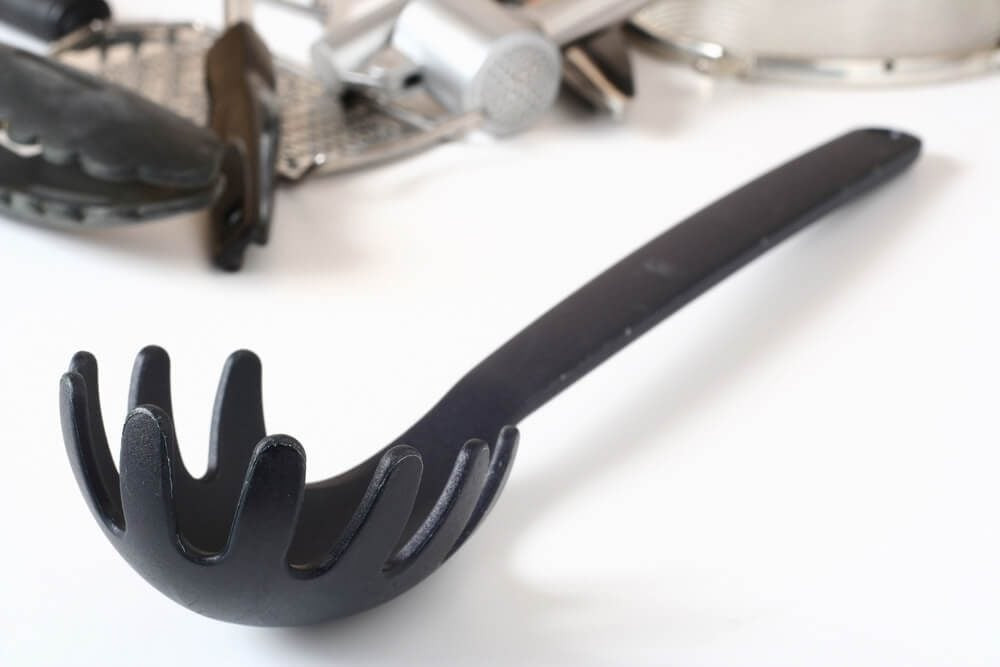Figuring out the right amount of spaghetti to cook can be tricky. You’re not alone if you’ve stared at a box of spaghetti wondering, “how much of this should I actually make?”. The age-old question of proper pasta portions has led to many supposed quick fixes, like the internet-famous pasta spoon hack. You might have heard that the hole in your pasta spoon is perfectly sized to measure a single serving of spaghetti. While a clever idea, relying solely on your pasta spoon’s hole can lead to either not enough pasta or mountains of leftovers.
 Measuring spaghetti portion using a pasta spoon portion hole, surrounded by kitchen utensils like whisk and ladle, highlighting the common but inaccurate method.
Measuring spaghetti portion using a pasta spoon portion hole, surrounded by kitchen utensils like whisk and ladle, highlighting the common but inaccurate method.
So, how do you actually measure the correct amount of spaghetti for one serving, or for your whole family? Forget relying on kitchen utensil myths. We’ve compiled a list of reliable and practical methods to ensure you cook just the right amount of spaghetti every time, leading to perfectly portioned pasta dishes and less food waste.
Beyond the Pasta Spoon: Reliable Spaghetti Portioning Methods
While the pasta spoon trick is a fun fact, its inconsistency across different spoon sizes makes it unreliable for accurate portioning. For truly accurate measurements, especially when it comes to spaghetti, it’s best to turn to methods backed by culinary standards and practical kitchen hacks. Here are several effective ways to measure your spaghetti servings:
1. The Quarter Comparison: USDA Recommended Portion
According to the USDA (United States Department of Agriculture), a standard serving of pasta is 2 ounces (56 grams) of dry pasta. This guideline is a great starting point for portion control, especially when watching calorie intake or ensuring balanced meals. For long pasta shapes like spaghetti, linguine, or fettuccine, the quarter method offers a visual and easy-to-use guide.
To use this method, simply take a handful of dry spaghetti and hold it vertically. Compare the diameter of the bundle to a quarter. When the thickness of your spaghetti bundle is roughly equal to the diameter of a quarter, you’ve got approximately 2 ounces of dry spaghetti, the recommended single serving size. This method is quick, requires no special tools, and is surprisingly accurate for everyday cooking.
2. The Palm Method: A Quick Hand Guide
For smaller pasta shapes like macaroni or penne, using your palm can be a convenient way to estimate a single serving. While this method isn’t ideal for long strands of spaghetti, it’s useful to know for other pasta types. A closed fist, loosely filled with dry pasta, roughly equates to about one cup of dry pasta.
Keep in mind that spaghetti is typically measured by weight or diameter rather than volume like smaller pasta shapes. While the palm method is less precise for spaghetti, it’s a handy trick for other pasta varieties and can be helpful when you don’t have measuring tools readily available and are cooking shapes like rigatoni alongside your spaghetti for a mixed pasta bake.
3. The Soda Bottle Hack: Consistent Size Matters
If you’re looking for a household item to help with spaghetti portioning that’s more reliable than a pasta spoon, a soda bottle can come to the rescue. The opening of a standard soda bottle is consistently sized, making it a surprisingly effective pasta-portioning tool.
To use this hack, take the opening of a clean and dry soda bottle. Tightly fill the diameter of the opening with dry spaghetti noodles. The amount of spaghetti that fits snugly into the soda bottle opening is generally considered a single serving. This method is more consistent than the pasta spoon hole and provides a quick visual guide for portioning spaghetti.
4. The Food Scale: For Precision Portioning
For the most accurate measurement of spaghetti portions, especially if you are calorie counting or need precise servings for dietary reasons, a food scale is your best friend. Using a food scale eliminates guesswork and ensures you are cooking the exact amount of pasta you need.
Simply place a bowl on your food scale, zero out the scale (tare function), and then weigh out 2 ounces (56 grams) of dry spaghetti for a single serving. If you prefer to measure cooked pasta, aim for approximately 4 ounces (112 grams) of cooked spaghetti per serving, as pasta doubles in weight when cooked due to water absorption. A food scale provides unparalleled accuracy and is a valuable tool for any kitchen.
5. The Finger Circle: A Pinch Measurement
Another quick, albeit less precise, method involves using your fingers. Make a circle with your index finger and thumb. The diameter of this circle can serve as a guide for a single serving of spaghetti before cooking. Fill the center of your finger circle with long noodles. The amount that comfortably fits within this circle is roughly estimated to be a single portion.
It’s important to remember that hand sizes vary, so this method is less reliable than others, especially compared to weighing or using a quarter or soda bottle opening. However, in a pinch, the finger circle method can be a helpful visual guide when you need a quick estimate and don’t have other measuring tools available.
6. The Muffin Tin Method: Portioning Cooked Spaghetti
For pre-portioning cooked spaghetti, especially for meal prepping or batch cooking, the muffin tin method, popularized by chef Giada De Laurentiis, is an excellent technique. This method works after you’ve already cooked your spaghetti and are looking to create individual servings for later use.
After cooking your spaghetti, use tongs to place servings of cooked spaghetti into the cups of a muffin tin. Each muffin tin cup will hold approximately one portion of cooked spaghetti. You can then refrigerate these spaghetti “muffins” for use throughout the week, or freeze them for longer-term storage and quick meal assembly. This is a fantastic way to manage leftovers and ensure consistent portion sizes for future meals.
7. Divide by Servings on the Package: Package Guidelines
Lastly, don’t overlook the serving size recommendations provided directly on the pasta box. Most pasta packaging includes nutritional information and serving suggestions. For example, if a box of spaghetti states that it contains 8 servings, you can divide the entire box into 8 roughly equal portions before cooking.
To do this, simply empty the box of spaghetti onto a clean surface and visually divide it into the indicated number of servings. You can then place each portion into individual bags or containers for easy cooking later. While this method relies on visual estimation and the manufacturer’s serving size, it’s a straightforward approach for general portioning, especially when cooking an entire box of pasta at once.
Mastering Spaghetti Portions for Perfect Meals
Knowing how much spaghetti constitutes a single serving is key to preparing balanced and satisfying meals, whether you’re cooking for yourself or a crowd. By using these reliable methods – from the USDA quarter comparison to the precision of a food scale – you can move beyond unreliable hacks and confidently cook the perfect amount of spaghetti every time. Say goodbye to pasta waste and hello to perfectly portioned, delicious spaghetti dishes!

